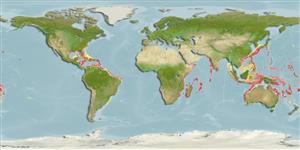>
Zeiformes (Dories) >
Parazenidae (Parazen) > Parazeninae
Etymology: Parazen: Greek, para in the side of + Greek, zen , zao = to live (Ref. 45335).
Environment: milieu / climate zone / depth range / distribution range
Ecologia
marino batidemersale; distribuzione batimetrica 145 - 500 m (Ref. 11897). Deep-water
Western Central Atlantic: northern Cuba (Ref. 26340). Indo-West Pacific: Natal (South Africa), Japan, and Taiwan (Ref. 11228); Chesterfield Island (Ref. 11897).
Size / Peso / Age
Maturity: Lm ? range ? - ? cm
Max length : 14.0 cm TL maschio/sesso non determinato; (Ref. 557)
Occurs on the continental slope. Benthic species (Ref. 75154).
Life cycle and mating behavior
Maturità | Riproduzione | Deposizione | Uova | Fecundity | Larve
Wheeler, A., 1977. Das grosse Buch der Fische. Eugen Ulmer GmbH & Co. Stuttgart. 356 p. (Ref. 557)
IUCN Red List Status (Ref. 130435: Version 2024-1)
Threat to humans
Harmless
Human uses
Pesca:
Strumenti
Special reports
Download XML
Fonti Internet
Estimates based on models
Preferred temperature (Ref.
123201): 11.5 - 20.7, mean 15.6 °C (based on 215 cells).
Phylogenetic diversity index (Ref.
82804): PD
50 = 1.0625 [Uniqueness, from 0.5 = low to 2.0 = high].
Bayesian length-weight: a=0.01122 (0.00514 - 0.02450), b=3.04 (2.87 - 3.21), in cm total length, based on all LWR estimates for this body shape (Ref.
93245).
Trophic level (Ref.
69278): 3.5 ±0.8 se; based on size and trophs of closest relatives
Fishing Vulnerability (Ref.
59153): Low vulnerability (10 of 100).
